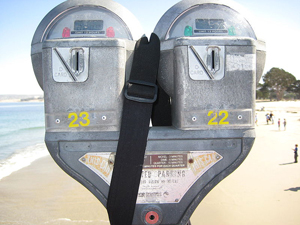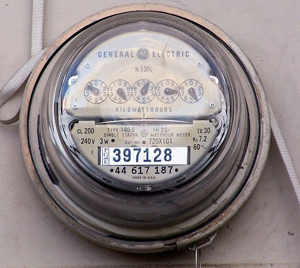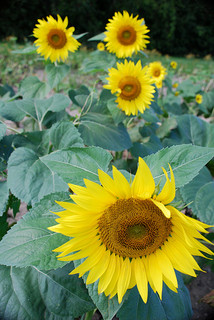
Source: ParkingMeter, Marlith, Wikimedia

Source: Electrical meter, mboverload, Wikimedia

Source: lopsided gas gauge, eliduke, Flickr
In the previous section of this lesson, you analyzed rhyme schemes, labeling a poem’s pattern of rhyming sounds with alphabetical letters. Meter is another element that contributes to a poem’s musical nature.
When you hear the word meter, you might think of a unit of length or a device for measuring something. For example, the thermostat in your home is a meter that measures room temperature. What is measured by each of the devices pictured above?
The parking meter measures the minutes remaining before you must insert more coins. The electric meter measures the amount of energy you are using in your house. The gas gauge measures the amount of fuel in the tank of your car.
In poetry, meter is the measuring stick for the rhythm, the beat or movement, in each line of the poem. Meter is created through the poet’s deliberate arrangement of words and syllables. Poets rely on stressed and unstressed syllables to create musical rhythm in a poem.
Complete the following Q and A activity. Once you think of answers to each question, check your understanding to see sample ones.
Question: Which syllable do you stress when you pronounce the word complete?
Sample Response:
Because you pronounce the word as com-PLETE (not COM-plete), you stress the second syllable, PLETE).
Question: Which syllable do you stress when you pronounce each of these words: poem, poetry?
Sample Response:
PO-em: The first syllable is stressed; the second is unstressed.
PO-et-ry: The first syllable is stressed; the second and third are unstressed.

Source: Shakespeare Flower, Wikimedia
The basic unit of meter is the foot, which consists of stressed and unstressed syllables. Stressed syllables are marked with this symbol: ´. Unstressed syllables are marked with this symbol: ˘. Poetry has different types of feet, depending on how the stressed and unstressed syllables are arranged in a line. For example, an iamb is a foot consisting of one unstressed syllable followed by one stressed syllable.
Lines of poetry are not only characterized by the type of feet they contain but also by the number of feet they have. For instance, a line of poetry that has five iambs would be described as iambic pentameter. The word pentameter tells you that there are five iambs in the line. Other terms used to describe the number of feet in a line of poetry are trimeter (three feet) and tetrameter (four feet).
Let’s return to iambic pentameter. Watch this video to learn more about the most common meter in English verse:
Now that you’ve watched the video, you have a helpful tool when analyzing meter in poetry. Keep in mind the sound of the galloping horse or the beating heart that you heard at the end of the video in order to remember iambic pentameter.
Shakespeare uses iambic pentameter in “Shall I Compare Thee to a Summer’s Day?” Read his sonnet, which appears below. As you read, try to determine the pattern of stressed and unstressed syllables. Reading out loud slowly, pausing briefly at the end of each line, will help you hear the galloping or beating rhythm.
Shall I Compare Thee to a Summer’s Day? (Sonnet 18)

Source: Summer Day, wuji9981, Flickr
Shall I compare thee to a summer’s day?
Thou art more lovely and more temperate:
Rough winds do shake the darling buds of May,
And summer’s lease hath all too short a date;
Sometime too hot the eye of heaven shines,
And often is his gold complexion dimm’d;
And every fair from fair sometime declines,
By chance or nature’s changing course untrimm’d;
But thy eternal summer shall not fade,
Nor lose possession of that fair thou ow’st;
Nor shall death brag thou wander’st in his shade,
When in eternal lines to Time thou grow’st:
So long as men can breathe, or eyes can see,
So long lives this, and this gives life to thee.
Scansion is the analysis of lines of verse to show their meter. The first line of Sonnet 18 below has been scanned. The stressed syllables are marked with this symbol: ´; the unstressed are marked with this symbol: ˘. The / symbol is used to show individual feet, where one iamb ends and another begins.
| ˘ | ´ | ˘ | ´ | ˘ | ´ | ˘ | ´ | ˘ | ´ |
| Shall | I | / com | pare | / thee | to | / a | sum | / mer’s | day? |
Now, it’s your turn to mark the stressed and unstressed syllables in the second line of the sonnet. Drag the stressed symbols to the five syllables that are stressed and the unstressed symbols to the five syllables that are not stressed. The line has already been divided into feet for you.

A poem’s form is determined by the number and length of its lines, the number of its stanzas, the rhyme scheme, and its meter. "Shall I Compare Thee to a Summer’s Day?" takes the form of an English, or Shakespearean, sonnet. An English sonnet has 14 lines, and each line consists of ten syllables. The syllables follow a pattern of unstressed, stressed, unstressed, stressed five times. Therefore, you know that an English sonnet is written in iambic pentameter.
The term blank verse refers to unrhymed lines of iambic pentameter. This is the verse found in Shakespeare’s plays. Read the lines below from Romeo and Juliet.
What’s in a name? That which we call a rose
By any other name would smell as sweet.
Juliet speaks these words in act 2. Each line consists of five feet (ten syllables), but the lines do not rhyme.
The term free verse describes poetry without a fixed pattern of meter or rhyme. It is distinguished from prose by the poet’s deliberate division of the lines. Read the lines below aloud.
Speaking indifferently to him,
who had driven out the cold
and polished my good shoes as well.
What did I know, what did I know
of love’s austere and lonely offices?
This last stanza from Robert Hayden’s “Those Winter Sundays” does not contain a regular arrangement of stressed and unstressed syllables, nor does it rhyme.
The next time you read a poem aloud or hear a song, listen for its meter. Tap your feet or clap your hands to the beat! You’ve got rhythm!